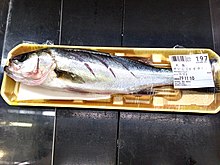Sea bass is a common name for a variety of different species of marine fish. Many fish species of various families have been called sea bass.

The white bass, silver bass, or sand bass is a freshwater fish of the temperate bass family Moronidae. commonly around 12-15 inches long. The species' main color is silver-white to pale green. Its back is dark, with white sides and belly, and with narrow dark stripes running lengthwise on its sides. It has large, rough scales and two dorsal fins. They are widely distributed across North America, inhabiting large reservoirs and rivers. When mating in the spring, they are more often found in shallow rivers, creeks, and streams. They have been introduced in some places as sport fish and also to predate on nuisance fish, such as gizzard shad. It is the state fish of Oklahoma.

The black sea bass is a species of marine ray-finned fish, a sea bass from the subfamily Serraninae which is part of the family Serranidae, which also includes the groupers and anthias. It is found in the western Atlantic Ocean, where it is an important species for commercial and recreational fisheries.

Dragonets are small, percomorph, marine fish of the diverse family Callionymidae found mainly in the tropical waters of the western Indo-Pacific. They are benthic organisms, spending most of their time near the sandy bottoms, at a depth of roughly two hundred meters. There exist 139 species of the fish, in nineteen genera.

The barramundi, Asian sea bass, or giant sea perch, is a species of catadromous fish in the family Latidae of the order Perciformes. The species is widely distributed in the Indo-West Pacific, spanning the waters of the Middle East, South Asia, Southeast Asia, East Asia, and Oceania.

Arripis is a genus of marine fishes from Australia and New Zealand, known as Australian salmon, kahawai and Australian herring. They are the only members of the family Arripidae. Despite the common name, Australian salmon are not related to the salmon family Salmonidae of the Northern Hemisphere, just as Australian herring are not related to herring of the Northern Hemisphere, but belong to the order Perciformes of perch-like fishes. Australian salmon were named so by early European settlers after their superficial resemblance to the salmoniform fishes.
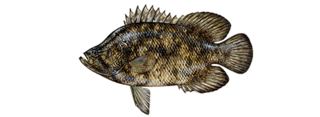
The Atlantic tripletail or tripletail is a warm-water marine fish found across the tropics; it can grow to 90 cm long and weigh 18 kg. It is also known by fishermen by names like flasher or steamboat. Young fishes float on their sides, often beside flotsam, and appear like a dry leaf.

The New Zealand smelt, also known as the New Zealand common smelt, New Zealand cucumber fish, or silveries is a smelt of the family Retropinnidae, found only in New Zealand at shallow depths in estuaries and rivers. Their length is between 8 and 13 cm.

King-of-the-salmon, Trachipterus altivelis, is a species of ribbonfish in the family Trachipteridae. Its common name comes from the legends of the Makah people west of the Strait of Juan de Fuca, which hold that this fish leads the salmon annually to their spawning grounds. Catching or eating king-of-the-salmon was forbidden, as it was feared killing one would stop the salmon run. This myth is reflected by a former specific epithet used for this fish, rex-salmonorum, rex being Latin for "king". The king-of-the-salmon is found in the eastern Pacific Ocean from Alaska to Chile. It is usually found in the open ocean to a depth of 900 meters, though adults sometimes feed on the sea bottom.

The Japanese bullhead shark is a species of bullhead shark in the family Heterodontidae found in the northwestern Pacific Ocean off the coasts of Japan, Korea, and China. This benthic shark occurs at depths of 6–37 m (20–121 ft) over rocky bottoms or kelp beds. Measuring up to 1.2 m (3.9 ft) long, it can be identified by its short, blunt head, two high dorsal fins with anterior spines, and pattern of irregularly shaped, vertical brown bands and stripes. The Japanese bullhead shark is a docile, slow-swimming species that feeds mainly on shelled invertebrates and small bony fishes. Reproduction is oviparous, with females laying spiral-flanged eggs in communal "nests". This species is of little interest to fisheries.

The southern school whiting, Sillago bassensis, is a common species of coastal marine fish of the smelt-whiting family that inhabits the south and south-west coasts of Australia. Its distribution overlaps a number of other common sillaginids, with careful observation of anatomical features occasionally needed to distinguish between species. The southern school whiting is closely related to the eastern school whiting, Sillago flindersi, and initially were thought to be all one species. The species inhabits both shallow inshore sandy waters, as well as deeper offshore waters, with a transition of habitats occurring with increasing age. It is a predatory fish, taking a variety of crustaceans, polychaetes and bivalves as prey. It reaches sexual maturity at three years of age, and spawns multiple times between December and April. The southern school whiting is commonly caught by commercial and recreational fishermen, often while fishing for related species, especially the sought after King George whiting. The species is marketed fresh in southern Australia.

The western trumpeter whiting, Sillago burrus, is a species of marine fish of the smelt whiting family Sillaginidae that is commonly found along the northern coast of Australia and in southern Indonesia and New Guinea. As its name suggests, it is closely related to and resembles the trumpeter whiting which inhabits the east coast of Australia and is distinguishable by swim bladder morphology alone. The species inhabits a variety of sandy, silty and muddy substrates in depths from 0 to 15 m deep, with older fish inhabiting deeper waters. Western trumpeter whiting are benthic carnivores which take predominantly crustaceans and polychaetes as prey. The species reaches sexual maturity at the end of its first year of age, spawning in batches between December and February. The species is taken as bycatch with other species of whiting and shrimps in Australia.
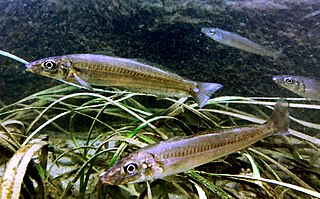
The Japanese whiting, Sillago japonica, is a common species of coastal marine fish belonging to the smelt-whiting family, Sillaginidae. As suggested by its name, the Japanese whiting was first recorded from Japan in 1843, but has subsequently been found to extend to Korea, China and Taiwan.
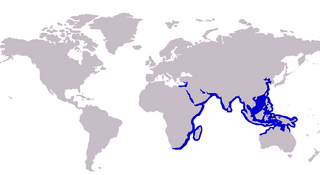
The northern whiting, also known as the silver whiting and sand smelt, is a marine fish, the most widespread and abundant member of the smelt-whiting family Sillaginidae. The northern whiting was the first species of sillaginid scientifically described and is therefore the type species of both the family Sillaginidae and the genus Sillago. The species is distributed in the Indo-Pacific region from South Africa in the west to Japan and Indonesia in the east, also becoming an invasive species to the Mediterranean through the Suez Canal. The northern whiting inhabits coastal areas to 60 m, but is most often found in shallow water around bays and estuaries, often entering freshwater. It is a carnivore, taking a variety of polychaetes and crustaceans. The species is of major economic importance throughout the Indo-Pacific. It is most frequently taken by seine nets and cast nets and marketed fresh.
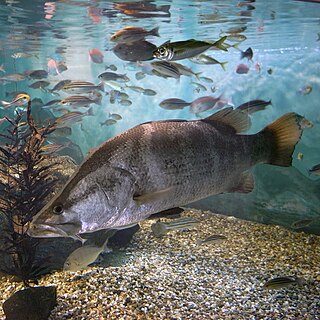
The Japanese lates, also known as the akame or Japanese barramundi, is a species of fish found in Japan. A bottom-dweller restricted to estuarine habitats and large rivers in the Pacific coastal western parts of the country, it is threatened by habitat destruction. As it is similar to the related barramundi, it was classified as the same species until 1984.

The blackfin seabass is a Perciforme fish in the family lateolabracidae, found primarily in the shallow waters of the Pacific coast of Asia, in Japan and in South Korea. There are only two species in the genus Lateolabrax, known as Asian seabasses. As a perciforme, the blackfin seabass is among the largest order of fish in the ocean. Blackfin seabass live in shallow, tidal or rocky surf zones, partially as a way to escape competition with the Japanese seabass Lateolabrax japonicus, a close and almost identical relative of theirs, and partially for the breeding opportunity in brackish water by the mouths of rivers.

Stephanolepis cirrhifer, commonly known as the thread-sail filefish, is a species of marine fish in the family Monacanthidae. It is found in the western Pacific, in an area that ranges from northern Japan to the East China Sea, to Korea. Other common names for the fish include kawahagi (カワハギ,皮剥) (Japanese) and “쥐치” "Jwi-chi" (Korean). The fish grows to a maximum length of about 12 inches, and consumes both plant material and small marine organisms like skeleton shrimp. S. cirrhifer is host of the parasite Peniculus minuticaudae. Some minor genetic differentiation between S. cirrhifer born in the wild and those bred in a hatchery for consumer use has been shown. The fish is edible and sold commercially for culinary purposes in many Asian countries.
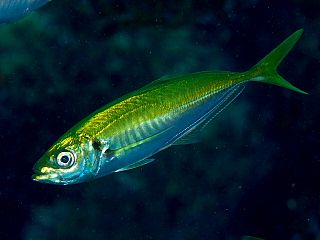
The Japanese jack mackerel, also known as the Japanese horse mackerel or Japanese scad, is a species named after its resemblance to mackerel but which is in the family Carangidae, the jacks, pompanos, trevallies and scads. Their maximum reported length is 50 cm (20 in) with a common length of 35 cm (14 in). They have a maximum reported weight of 0.66 kg (1.5 lb) and a maximum reported age of 12 years. They are found around the coast of Japan, apart from Okinawa Island, usually on sandy bottoms of 50–275 m (164–902 ft) deep. They feed mainly on small crustaceans such as copepods, and shrimps and small fish. They are similar to the yellowtail horse mackerel around New Zealand and Australia, apart from having more gill rakers and larger eyes.

Trachidermus fasciatus is a species of fish in the superfamily Cottoidea, the sculpins, and the only member of the monotypic genus Trachidermus. Its common name is roughskin sculpin. It has also been called four-gilled perch. It is native to the coastlines of China, Japan, and Korea, where it occurs at the mouths of rivers.

Acanthogobius flavimanus is a species of fish in the goby family known by the common name yellowfin goby. Other common names include mahaze, Japanese river goby, Oriental goby, and spotted goby. It is native to Asia, where its range includes China, Japan, Korea, parts of Russia, Vietnam, and Malaysia. It has spread beyond its native range to become an introduced, and often invasive, species. It has been recorded in Australia, Mexico, and Florida and California in the United States.



